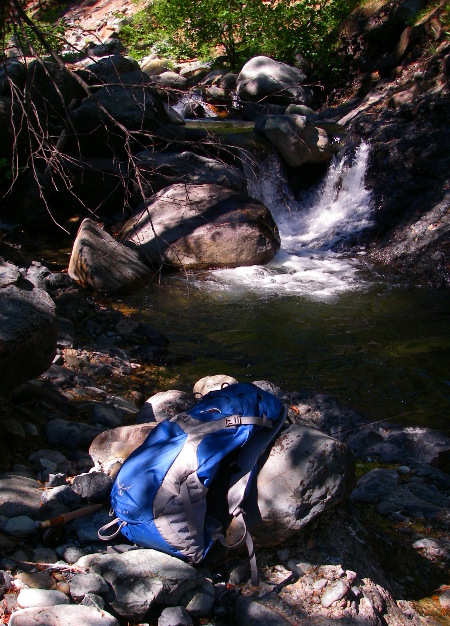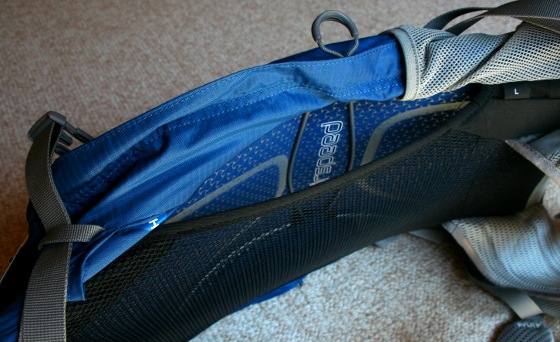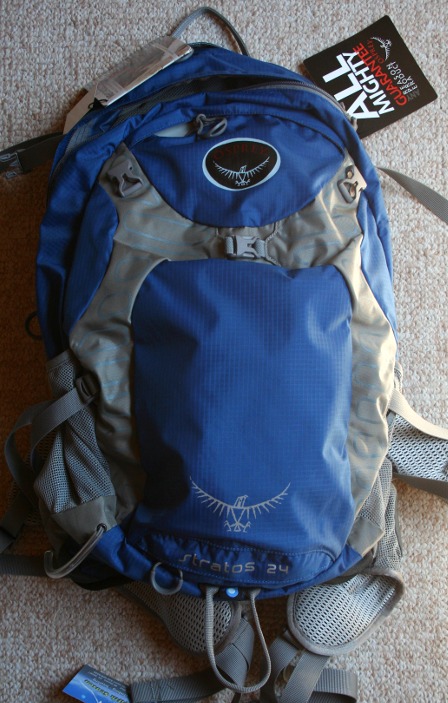Category:
Fly Fishing fly fishing pack fly fishing stuff osprey stratos 24 Review
Added Date:
Wednesday, 28 Sep, 2011
Summary
The Osprey Stratos 24 daypack I boughta couple weeks ago has seen a handful of small stream trips, and due to a couple inquiries, I'd gather it's time for a quickie review.
Content
The Osprey Stratos 24 daypack I boughta couple weeks ago has seen a handful of small stream trips, and due to a couple inquiries, I'd gather it's time for a quickie review.  First, it's comfortable. Very comfortable (ohhh, the comfort). The trampoline style back support eliminates the hiker's dreaded sweaty back, and it hugs my torso like a frightened monkey.
In fact, one of the best things you can say about a pack is that you forgot it's there, and with this pack I always forget it's there. However, that comfort comes at a cost; the pack's support stays are deeply dished, and while they keep your back cool and purring, the curve limits the amount of stuff you can jam in the pack (especially bulky items).  For warm-weather use, that's not a problem; I could easily carry a day's load (reel, rod, neck pack, lunch, jacket, spare fly boxes, pack stove, Wally food, etc). Still, if you wanted to carry full-bore fishing kit (waders, boots, big vest, lots of fly boxes, big lunch, rain jacket, etc) on a long hike, you'd need to lash the boots on the outside, which isn't this pack's forte. I could probably find a way, but small, warm weather day packs tend to lack a lot of exterior lash points. If I regularly carried fly fishing's full catastrophe of gear, I'd probably opt for my larger Lowe winter pack, which -- like most winter/snowboard/ski packs -- offers a snowboard/snow shovel flap (a great place to stow wet boots). Life, it seems, remains a series of compromises. Neatly illustrating the principle of alien perspective is this: Older Bro thinks this style of pack is too big for most day trips, and has settled on a glorified hydration pack. Read More The Underground Picks the Dozen Best Fly Rods of All Time Period So much for simple. That said, I think this is a brilliant day pack, and for most of my fishing, which involves hiking in my wading boots with a little extra gear and lunch and Wally food and the other stuff we burden ourselves with, it's the real thing (and ohhh, the comfort). In a nod to life beyond fly fishing, the Stratos 24 is the perfect size for a hike with the family (lunch, jacket, kid gear, dog stuff, wife stuff, camera, backup stuff for the stuff you lose along the way...).
The Summary
The Osprey Stratos 24 is a small daypack that more than punches its weight (full disclosure: I bought this sucker, and at full retail).  It's basically heaven with straps (ohhh, the comfort), and it's clearly designed by people who regularly use packs: all the straps adjust easily, and it's got enough handy little pockets to satisfy your inner Navy Seal. The big questions revolve around capacity and the lack of external lash points. A few features:
- One main compartment (with hydration sleeve)
- Two side mesh pockets (water bottle, rod tube)
- Two top-loading small pockets
See you on the trail, Tom Chandler.
(2)
This is a small town with a big heart, a veritable fisherman’s paradise. Located near the fish-filled Madison River, and surrounded by the waters of Ennis Lake, the Ruby River, Hebgen ... moreLake, Quake Lake, Henry’s Lake, the Big Hole River and scores of smaller streams, the town boasts what many consider the best trout fishing in the world. As well known for its wranglers as its anglers, Ennis has succeeded in maintaining the look and feel of its original, gold town roots. Warm and hospitable, the area offers a wide variety of accommodations ranging from simple campsites, rustic motels and gracious hotels, to full-service, luxury resorts. Fly shops are numerous, stocked by local experts ready to advise and assist, while guides can be booked for trips throughout the area.
Boredom is the only thing unavailable in Ennis. Throughout the summer season the city hosts a series of events, including its renowned 4th of July Celebration Parade and a genuine, old-fashioned rodeo. In August, fly-fishing luminaries from around the US, flock to Montana to compete in the Madison Fly Fishing Festival. Athletes also find their way to Ennis to compete in the city’s Madison Trifecta, two shorter races followed by a full Marathon at 9000 feet, the highest elevation run in America. For the true sportsman, October falls in with the annual Hunter’s Feed. What’s caught, typically elk, moose deer, pheasant and bobcat, gets cooked on the streets and served up to hungry spectators.
Flanked by three grand mountain ranges, The Tobacco Root, Gravelly and Madison, Ennis is scenic and entertaining – truly an authentic, fly fisher’s haven.
(1)
Maclean’s famous story, A River Runs Through It, is set on the now famous Blackfoot River. Despite this, Robert Redford’s 1992 movie version was largely filmed on the Gallatin as he ... morefelt the scenery and fishing were more cinematic. The river originates high in the mountains of the Gallatin Range inside Yellowstone National Park and flows for 115 miles until it intersects with the beginning of the Missouri River at Three Forks. Inside the Park, where it runs for more than 25 miles, floating is not allowed and there are restrictions on fishing. Once it exits the park, it crosses a forty-mile expanse of mostly public lands, and runs parallel to a highway that makes it quite accessible. Because the river is narrow for much of its run, float fishing is restricted from Yellowstone Park to the confluence with the East Gallatin River. No wonder this river has a great reputation for wade fishing!
Unimpeded by dams, the river provides consistent, easily waded flows from mid-summer through mid-spring. Rainbows predominate with an estimated 1400, 8+ inch, fish per mile from the West Fork confluence at Big Sky to the mouth of the canyon. Browns are abundant accompanied by occasional cutthroats, brook trout, white fish and graylings. New to the lower most band of the river are northern pike. Never known for trophy trout, the river offers excellent dry fly fishing and beautiful surroundings. Since the fish are recognized as indiscriminate eaters, the Gallatin has come to be known as an excellent river for those learning to fly fish.
Like much of Montana, the River played a significant role in the state’s history. First explored by Native American hunters, by the early 1900’s, the area eventually became known to fur-trappers and gold prospectors. By the turn of the twentieth century logging rose in importance to the local economy as loggers famously rode the logs down river to prevent them from jamming. The towns of Bozeman and Three Forks are most closely associated with the River although given the importance of Maclean’s legacy, Livingston should also be considered as part of its history and heritage.
(2)
The Jefferson River is an important part of a system of rivers that combine to form the majestic Missouri. Starting at the confluence of the Big Hole and Beaverhead rivers near Twin ... moreBridges, Montana, it winds 77 miles in a northeasterly fashion to Three Forks. Here, it meets with the Madison and Gallatin rivers that together converge into the Missouri River at the Missouri Headwaters State Park. Like so many other rivers in Montana, the Jefferson, named by Clark in honor of the U.S. President, runs deep with history. In fact, the Jefferson River is a segment of the larger Lewis and Clark National Historic Trail, administered by our National Park Service.
When thinking about the Jefferson, a Class 1 river for recreational enjoyment, most observers view the river in three distinct sections. Characterized by slow, meandering flows, the upper third works its way through a broad, arid valley. Along this braided, 44 mile long floodplain, you will encounter working farms, dense cottonwood stands, flowered meadows and a variety of wildlife until you reach the town of Cardwell. Throughout the next 15 miles, its waters flow through a narrow, steep canyon where the water can be deep, slow and contained. As a result, the stretch from Cardwell to the Sappington Bridge has comparatively fewer trees, swamps, meadows and wildlife.
At Sappington Bridge the river once again becomes a circuitous, rambling river, rich in swamp life, colorful fields, large cottonwood groves and productive agricultural land. The presence of significant agriculture has resulted in competition for water use. During dry years, the river was tapped generously for irrigation, dropping water levels to the point where fish populations were adversely affected. Recent improvement in riparian management has tended to alleviate these issues. Primarily known as a brown trout river, rainbows, mountain whitefish, burbot and northern pike can also be found here. Less well known and less discovered, the Jefferson offers the opportunity to catch large fish in a scenic, un-crowded environment.
(5)
The Madison River is arguably one of the best trout fishing rivers in all of southwest Montana, if not the entire world! It’s certainly the most talked over, written up and frequented ... morein the state of Montana – which is considered by some the capital of fly fishing. Anglers will find plenty of great access sites to wade or float along the Madison’s banks and reservoirs (including Hebgen Lake and Ennis Lake). Rainbows, browns, cutthroats, and more abound in this majestic fishing stream.
The Madison begins its course almost twenty miles into Yellowstone National Park. Within the Park, fishing rules apply: no live bait and catch and release only. Once outside the Park the river meanders past working ranches, stately conifer forests and cottonwood lined banks, interrupted by riffles and quiet runs that contain large rainbow and trophy brown trout. Flowing alongside Yellowstone’s West entrance road, the river enters Hebgen Lake, created by Hebgen dam, until it reaches Quake Lake, a bit downstream from the dam. At this point the river is commonly called either the Upper Madison or the Lower Madison, although in fact, they are one and the same.
Upper Madison – Quake Lake to Ennis Lake
Directly below Quake Lake the river roars into 5 long miles of Class V whitewater with steep gradients and large boulders along the way. As the rapids decline, the magic begins. For the next 53 miles, often referred to as the 50 Mile Riffle, the cold river runs north and the fish jump high. Annual runs of spawning trout make their way from Hebgen Lake, rainbows in the spring and browns in the fall. Known the world over for its “hard fighting” trout, it’s not unusual to pull a 25” brown from these upper waters. In deference to the purists and fly-fishing enthusiasts, it’s wading only from Quake Lake to Lyons Bridge. Boats may be used to access the river, but if you’re going to fish, your feet must be on the riverbed. Fortunately, the Hebgen Dam releases water throughout the year, leveling its flows and relieving it of spring runoff issues and summer shrinkage.
Lower Madison – Ennis Lakes to Three Forks
A short section of the river between Ennis Dam and the power station maintains relatively low water levels and provides wonderful opportunities for wading. Past the power station the river regains its muscle and for 7 miles winds through Bear Trap Canyon. Hiking trails offer the only entry, great for those that like to walk and seek the solitude of a designated wilderness area. Floating is permitted but requires a lengthy shuttle and the ability to work through Class III-IV whitewater. Once out of the canyon the river flows in shallow riffles until it reaches Three Forks and joins the Missouri. From Warm Springs to Greycliff, the river is easily accessible for drifters and wading.
The Gallatin River is one of the closest, in proximity to Bozeman, Montana. As it makes its course from Yellowstone National Park to the Headwaters of the Missouri River, the Gallatin ... moreRiver flows through a diverse topography. High mountain meadows near Yellowstone Park, robust pocket water through the Gallatin Canyon, and the wide open spaces of the Gallatin Valley offer three distinct environments in which to fish and explore this fine river. Since it is smaller than many of our other rivers, the Gallatin offers a good opportunity for fishing on foot. Consistent hatches of caddis, mayflies and stoneflies throughout the season make the Gallatin an easy choice on any day.
Experience the Madison River Like Never Before
Learn the best spots on the Madison River with 5 great fishing days with Red Mountain Adventures. Eric Shores, with over 35 years of ... moreexperiencing guiding on the Madison River will take you down a journey of the best places to fish.
The journey starts on the Upper Madison River on a guided float trip covering about 8-11 miles of premier fly fishing water. The following day includes a recipe (location flies, and technique) on a do it yourself wade location near the fly fishing town of Ennis. The third day moves you on to where the Madison River dumps into Ennis Lake for a full float day stalking the giants. The following day provides instructions again for a do it yourself wade day. Location will depend on the hot locations during your visit. The final day is another full day float day on the lower Madison River. All together, you will experience the Madison River like never before by true expert.
Note: The order or location may change based on where the best spots are at the time.
With over 55 combined years of experience fishing the Montana rivers, we have the deep knowledge needed to guide you down this Blue Ribbon River. Located in Ennis, Montana, one of ... morethe top fly fishing towns in the world, Red Mountain Adventures is conveniently located to help you with your fishing experience on the Gallatin River.
Our guided float trips on the Gallatin River are perfect for novices to experts who gain from our deep knowledge and instruction on the Gallatin River. Book with us today and enjoy the best in Montana fly fishing.
(1)
Welcome to Southwest Montana's finest fly fishing adventures. Blue ribbon trout water is literally steps away when you visit us in the picturesque town of Ennis, Montana. You may spend ... morethe day on our home river, the world famous Madison or drive to one of our other local rivers such as the Big Hole, Beaverhead, Ruby or the Jefferson. Whether you are a new angler or an old pro we have the expertise and patience to make your time on the water chasing wild trout a success.
|